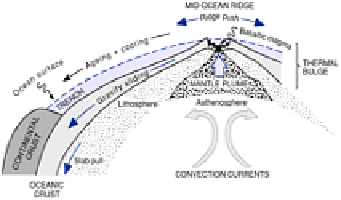Environmental Engineering Reference
In-Depth Information
point of upper mantle rock at the pressures found there. Since continental lithosphere is
lighter and cooler than oceanic lithosphere, the boundary is found at mean depths of 100-
150 km and 70-80 km below each respectively. It was thought originally that plates were
moved by
viscous drag
, coupling the base of the lithosphere to the asthenosphere, as
convection cells in the latter spread out over a rising
mantle plume
and rafted crust
around the Earth. The cooling limb of the cell would eventually return into the mantle.
This convective drive does not account for enough of the thermal energy dissipated at the
surface, however, and is augmented by gravitational effects at plate margins. In essence,
the ascending convection current develops a
thermal bulge
in lithospheric slab, which
then slides away under gravity. Cooling as it moves and ages, it eventually subsides into
the subjacent warmer asthenosphere and develops a gravitational pull. This mechanism
decouples the lithosphere from the asthenosphere, as melting reduces friction at their
common boundary and
ridge push
or
slab pull
gravity forces are applied at opposite
ends of the lithospheric slab (Figure 1).
Figure 1
The forces operating on a lithospheric plate, triggered by
mantle convection currents.
This combination of thermally direct and gravity-induced forces accounts for plate
motions and imparts direction and velocity to them. Simultaneously, ascending currents
transport the raw material of new crust with them and descending currents recycle older
crust back into the mantle. These processes, acting at opposing ends of the 'crustal
conveyor belt', broadly maintain a continuity of mass, since it appears that Earth is
neither expanding nor contracting. If anything, global continental crust is growing
extremely slowly at the expense of ocean crust. An estimated 12-15 km
3
of crust is
recycled annually in this way.
consolidated emerging theories of dispersal by
continental drift
to propose the former
existence of a single land mass, Pangaea, on the basis of a common geological history
culminating in a great Carboniferous - Permian glaciation. This was consistent with
Darwin's belief in common biological ancestry, with modern species found in different
continents once connected by land bridges or, ironically, natural rafts. No proven
mechanism of crustal rifting existed prior to 1960, despite considerable geological
evidence of
palaeo-
(past) climatic, palaeoenvironmental and palaeoecological evidence
for the supercontinent of Pangaea until its break-up in the Mesozoic era
c
. 200 Ma ago.





